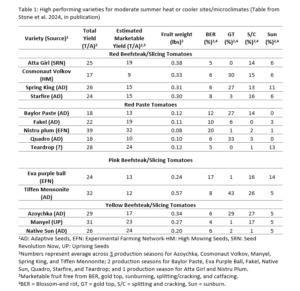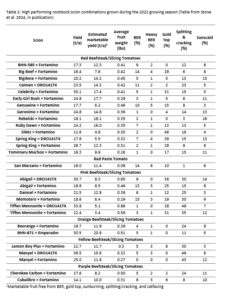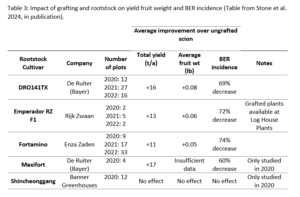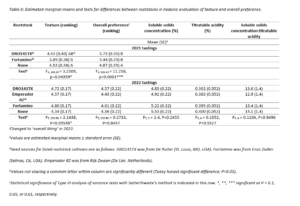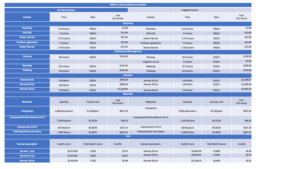Final report for SW20-917
Project Information
Farmers in the west are increasingly affected by reductions in summer irrigation availability due to early and reduced snowmelt and increased temperatures and drought. In addition, some farmers have no or limited water rights. This project is integrated with and led by the Dry Farming Collaborative, a group of farmers, extension educators, and agricultural professionals partnering to increase knowledge and awareness of dry farming practices. The project will support farmers in the production of flavorful tomatoes without supplemental irrigation (dry-farming), by engaging farmers in project development and evaluation, describing best soil management practices, identifying productive varieties and/or rootstock/scion pairs, evaluating dry-farm tomato crop profitability, evaluating sensory quality, developing recipes, promoting dry-farmed tomatoes, engaging other farmers in project, and evaluating project outcomes. The effect of tillage, organic mulching, compost amendments, rolled high biomass cover crops, and weed control strategies on plant available water and tomato yield and quality will be evaluated. Drought-tolerant tomato germplasm including Mediterranean dry-farm landraces, as well as grafting of diverse tomato types onto drought-tolerant rootstocks, will be evaluated for fruit productivity and quality in Oregon and California. Farmers will be engaged through the Dry Farming Collaborative Facebook group, listserve, field days, and winter meetings. Outcomes will be identified through paper and online evaluations at project end. Results will be extended to additional audiences through the publication of two journal articles (soil management and varietal performance) and a comprehensive dry farm tomato production extension bulletin, as well as presentations at grower meetings in Oregon and California. This project will reduce summer irrigation water use and thereby increase in-stream flows for aquatic organisms, and enhance farm system resilience to climate change. It will eliminate the need for costly and energy intensive irrigation systems, increasing profitability and reducing greenhouse gas emissions. It will allow farmers on lands with no or limited irrigation rights to grow profitable crops with little to no risk, thereby increasing profitability and quality of life.
Building on past and ongoing efforts, this project will:
- Engage farmers in development, delivery and evaluation of project
- Describe best soil management practices
- Identify productive varieties and/or rootstock/scion pairs
- Evaluate profitability of dry farmed tomatoes
- Evaluate sensory quality and develop recipes
- Promote dry farmed tomatoes
- Engage other farmers in project
- Evaluate project outcomes
Ongoing:
- Engage Dry Farming Collaborative/others through social media/listserve
YEAR ONE (5/2020 – 4/2021)
Spring
- Project Team call: planning
- Source seeds
- OSU staff trained to graft by GTF/Log House
- Grow/purchase transplants
- Apply treatments to soil management experiment, collect soil samples, install sensors
- Plant on-farm trials (Early Girl/Fortamino plants)
- Plant field experiments (California, on-farm, OSU)
Summer/fall:
- Collect harvest data
- Coordinate/evaluate 2 field days in August
- Analyze data
- Prepare soil management field for year 2 (cover crop, soil amendment)
Winter:
- December Project Team call –wrap-up
- Analyze data, submit reports to farmers, germplasm sources, and WSARE
- Winter meeting – reporting/evaluation/discussion/planning all project activities
- Farmers start Know Your Costs course, cohort meets, farmers develop plans
- February Project Team call – planning
- OSU grafting chamber contruction
YEAR TWO (5/2021 – 4/2022)
Spring
- Source seeds
- Grow/graft/purchase transplants
- Apply treatments to soil management experiment, collect soil samples for analysis, install sensors
- Plant on-farm trials (high performing tomato and/or soil management strategy)
- Plant field experiments (California, on-farm, OSU)
Summer/fall:
- Collect harvest data in all trials
- Assist farmers with profitability data collection
- Coordinate/evaluate 2 field days
- Analyze data
Winter:
- December Project Team call – wrap-up
- Analyze data, develop and submit reports to farmers, germplasm sources, and WSARE
- Coordinate/deliver/evaluate winter meeting – reporting/evaluation/discussion/planning all activities
- Presentation at Organic Seed Conference
- Farmers complete Know Your Costs course, Murray/cohort meets to analyze data
- Develop Cost of Production Analysis
- February Project Team call – planning
YEAR THREE (5/2022 – 4/2023)
Spring:
- Source seeds
- Grow/graft/purchase transplants
- Plant on-farm trials (high performing tomato and/or soil management strategy)
- Plant field experiments (California, on-farm, OSU)
Summer/fall:
- Collect harvest data
- Coordinate/evaluate 2 field days
- Analyze data
Winter:
- December Project Team call – wrap-up
- Analyze data, submit reports to farmers
- Coordinate/deliver/evaluate winter meeting – reporting/discussion/evaluation all activities
- Post-project evaluation survey sent to farmers, analyzed
- Publication of 2 journal articles and bulletin
- Presentations at NWHS, Ecofarm, Organicology, Small Farms
- March/Final Project Team call – wrap-up/evaluation
- Final SARE report
Cooperators
- - Producer
- - Technical Advisor (Educator)
- (Educator)
- - Producer
- (Educator)
- - Producer (Researcher)
- - Producer
- (Educator)
- - Producer
Research
Research Objectives addressed in 2021:
- Describe best soil management practices
- Identify productive varieties and/or rootstock/scion pairs
Objective: Describe best soil management practice
A soil management field trial was conducted in 2020 and 2021 at the OSU Vegetable Research Farm on a Chehalis silt loam. The trial was a randomized complete block design with four replications and eight treatments. In addition to a clean cultivated control, there were three floor management treatments, a dust mulch treatment (floor rototilled to 6-8 inches after rain events), a leaf mulch treatment (4 inches of leaf mulch), and a weedy treatment (weeds not controlled). Amendment treatments were high compost, gypsum, high N fertilizer (160 lbsN/acre) and low N fertilizer (40 lbs N/acre).
Cover crops were terminated in April. Compost was then applied at a rate of approximately 50 wet tons/acre. After application, all plots were tilled to incorporate compost and cover crop except for the leaf mulch treatment. Leaf mulch was applied to the soil surface in April. During the growing season, plots were kept free of weeds. The dust mulch treatments were tilled after rain events using a rototiller. The high rate of compost and control treatments were clean-cultivated with wheel hoes. The leaf mulch treatments were hand weeded.
Each five-plant plot of Early Girl tomato was bordered on all sides with 16 tomato plants. Data collection included plot fruit weight, fruit count, BER light weight, BER light count, BER heavy weight, BER heavy count, sunscald weight, and sunscald count. Additionally, watermark sensor data was collected.
Soil moisture content:
Watermark sensors (Irrometer, Riverside, CA, USA) were installed to a depth of 38, 69, 99, and 130 cm and data was recorded weekly.
Data analysis: Data analysis was performed using R in the RStudio environment (R Core team, 2019; RStudio Team, 2018). The effect of block and treatment on the response variables was analyzed using ANOVA. Block and treatment were included in the model as fixed effects. Treatment effect was tested using extra sum of squares F-tests. Estimated marginal means and standard errors for the different treatments were reported, and mean separation was performed using Tukey HSD.
Objective: Identify productive varieties and rootstock/scion pairs
Research station variety trials: Variety trials were conducted at the Oregon State University Vegetable Research Farm on a Chehalis silt loam for three seasons. Across the three years, 146 unique ungrafted slicer and beefsteak varieties, 45 unique paste tomato varieties, and 95 unique rootstock x scion combinations were evaluated. Data collection included plot yield, plot fruit count, average fruit weight, fruit with BER light (count and weight), fruit with BER heavy (count and weight), and estimates of fruit with gold top, splitting/cracking, sunscald, and catfacing. Total yield (tons/acre), total fruit count (fruit/acre), average fruit weight, estimated marketable yield (fruit without physiological disorders), and portion of fruit with BER, heavy BER, gold top, splitting/cracking, sunscald, and catfacing were quantified.
On-farm trials: On-farm trials were conducted on sites with soils with high water holding capacity to evaluate dry-farmed tomato performance on diverse sites and so farmers could evaluate promising varieties. In 2021 five high performing (in 2020) tomato scions (Astrakhanskie, Azoychka, Baylor Paste, Cosmonaut Volkov, and Marmande), ungifted and grafted onto DRO141TX, were trialed on four farms. In 2022, Big Beef and BHN 871 grafted onto DRO141TX and Fortamino (2 x 2 factorial) were trialed on four farms. Harvest data collection was the same as for the OSU Vegetable Research Farm variety trials.
Objective: Evaluate sensory quality and develop recipes
A variety of formal and informal tomato tastings were conducted over two years to 1) identify tomato varieties with good sensory quality, 2) determine if grafting had an effect on sensory quality, and 3) determine if dry farmed tomatoes had more intense flavor than irrigated tomatoes. Some of the methods are described below.
CSA Farm Tasting: CSA members were offered two sets of tomatoes (yellow-Azoychka and red-Cosmonaut Volkov). These tomatoes were grown in one of four treatments: grafted to Emperador and dry farmed; grafted to Emperador and irrigated; nongrafted and dry farmed; and nongrafted and irrigated. Tomatoes were evaluated for texture and overall liking (scale of 1-7 with 7 being the best), and were described as being “Balanced sweet and sour”, “More acidic than sweet”, or “More sweet than acidic”, and there flavor was described as “Mild”, “Intense”, or “Bad/Off-flavored.
Focus groups of farmers and marketers/retailers: Participants evaluated 10 cultivars and ranked their appearance, flavor, texture, and willingness to buy on a scale of one to three with one being excellent, two being acceptable, and three being unacceptable. Results were averaged across all participants.
Dry Farm Tomato Festival: Tasters received a tasting kit containing two ungrafted tomato varieties both irrigated and dry farmed. Varieties used for these taste tests were Early Girl and Big Beef (reds), Spring King and Tiffen Mennonite (pinks), and BHN 871 and Manyel (yellows). Tomatoes were evaluated for texture and overall liking (scale of 1-7 with 7 being the best), and were described as being “Balanced sweet and sour”, “More acidic than sweet”, or “More sweet than acidic”, and there flavor was described as “Mild”, “Intense”, or “Bad/Off-flavored.
Objective: Evaluate profitability of dry farmed tomatoes
Cost to grow tomatoes was measured using the “Know Your Costs to Grow” methodology created by Oregon Tilth. Time trials were conducted to determine the labor requirements to complete weeding, planting, and harvesting activities.
OBJECTIVE: Describe best soil management practices
Soil management trials: The treatment with the highest marketable yield was the low nitrogen fertilizer application treatment and the lowest marketable yield was for the weedy treatment. The dust mulching and gypsum treatments did not differ from the control. High fertilizer nitrogen was associated with high blossom end rot incidence. High compost and leaf mulch treatments resulted in high total fruit numbers, but fruit weight was low and blossom end rot incidence was high. In summary, dry farm tomato soil management recommendations include 1) clean cultivation to control weeds and minimize soil disturbance, and 2) moderate N fertilization (amendments and fertilizers), as excess N generates high blossom end rot incidence later in the growing season.
Watermark sensor data showed that soil moisture decreased at 6-9 inches and 12-15 inches depth (Table). Sensors at 24-27 inches and 36-39 inches did not detect significant water loss. Soils in the leaf mulch treatment retained more moisture than the other treatments at both 6-9 inches and 12-15 inches.
Table: Mean soil water potential at two depths on three dates
|
Treatment |
July 13, 2021 |
August 17, 2021 |
September 15, 2021 |
|||
|
Soil Water Potential at 6-9 inches |
Soil Water Potential at 12-15 inches |
Soil Water Potential at 6-9 inches |
Soil Water Potential at 12-15 inches |
Soil Water Potential at 6-9 inches |
Soil Water Potential at 12-15 inches |
|
|
High Compost |
-40 (6) A |
-10 (3) AB |
-87 (9) A |
-31 (4) A |
-126 (15) A |
-58 (7) A |
|
Control |
-50 (6) A |
-17 (3) A |
-124 (9) A |
-45 (4) A |
-172 (15) A |
-83 (7) A |
|
Dust Mulch |
-64 (6) A |
-13 (3) A |
-124 (9) A |
-36 (4) A |
-161 (15) A |
-63 (7) A |
|
Leaf Mulch |
-1 (6) B |
0 (3) B |
-20 (9) B |
-4 (4) B |
-32 (15) B |
-19 (7) B |
|
F-Statistic |
F3, 9 = 18.581, p=0.0003 |
F3, 9 = 7.506, p=0.0080 |
F3, 9 = 27.755, p<0.0001 |
F3, 9 = 17.290, p=0.0004 |
F3, 9 = 17.385, p=0.0004 |
F3, 9 = 15.755, p=0.0006 |
OBJECTIVE: Identify productive varieties and/or rootstock/scion pairs
Fourteen tomato varieties were identified that are resistant to BER (Table 1). However, these varieties have unacceptably soft fruit when daytime temperatures exceed 95F for several days, and many are susceptible to other physiological disorders including gold top, splitting and cracking, and sunscald. These varieties could be successfully dry-farmed in cooler areas of western Oregon (foothills, coast) or on protected/modified sites (shading, windbreaks, high relative humidity due to nearby overhead irrigation, etc).
High performing rootstock x scion combinations were also identified (Table 2). Grafting can increase fruit number, fruit weight and reduce BER incidence, thereby increasing marketable yield. However, grafting does not increase fruit firmness in varieties with unacceptably soft fruit when daytime temperatures are high; only genetically firm-fruited varieties should be grown on sites with very high daytime temperatures.
Most rootstocks tested (DRO141TX, Fortamino, Emperador, Maxifort) increased yield and reduced BER incidence to some degree, but Shincheonggang did not. (Table 3).
Objective: Evaluate sensory quality and develop recipes
1) identify tomato varieties with good sensory quality
All recommended tomato varieties (above) were determined to have good sensory quality in taste tests.
2) determine if grafting had an effect on sensory quality
In some but not all taste tests, tomatoes grown on grafted plants were considered to have lower sensory quality than tomatoes grown on ungrafted plants.
3) determine if dry farmed tomatoes had more intense flavor than irrigated tomatoes.
Dry-farmed Early Girl tomatoes grown in coastal California are known for their intense flavor, which is accompanied by a relatively small fruit size and 15% average BER incidence (Leap et al., 2017). Because of this dry farm tomato example, many farmers and consumers think that dry farm tomatoes are inherently more intensely flavored than irrigated tomatoes. However, in taste trials of Early Girl and high performing dry farm tomato varieties grown with and without irrigation in western Oregon, consumers described dry farm and irrigated tomatoes as similarly flavorful (data not shown).
Objective: Evaluate profitability of dry farmed tomatoes
Table 6 (Cost and Revenue Analysis) shows the comparative costs associated with growing dry-farmed and irrigated tomatoes. The table uses data from the OSU 2022 and 2023 growing seasons. An important consideration in dry farm tomato production is low marketable yield. Dry farm total yields are lower than irrigated yields, and high incidence of physiological disorders (BER, gold top) further reduce marketable yields. Fortunately, production costs can be lower in dry farm systems. For example, in 2022, dry farm weeding costs were half of irrigated weeding costs, and in dry farm production there are no costs associated with irrigation. Dry farmed tomatoes grown on suitable sites can be profitable.
Research Outcomes
This project identified tomato varieties and scion-rootstock combinations (see tables) useful for dry farm tomato production systems in western Oregon. Utilization of these varieties and grafting in dry farm systems decrease dry farm production risks and increase profitability. Dry farming reduces use of irrigation water and energy, increasing environmental sustainability.
The project also demonstrated that clean cultivation and mulching increased soil moisture content later in the production season, and clean cultivation increased tomato yield and quality. Dry farmers should not over-fertilize tomatoes with N as high N fertilization increases blossom end rot incidence, reducing marketable yield.
Breeding of tomatoes and rootstocks for adaptation to dry farm systems would likely improve dry farm tomato productivity and quality and reduce losses to physiological disorders such as blossom end rot, gold top, and cracking.
Education and Outreach
Participation Summary:
Project website
- Dry Farm Tomato Production. Oregon State University, Dept of Horticulture. https://tinyurl.com/dryfarmtomato. All project reports and presentations are available from this site.
Fact sheets
- How to evaluate your site for dry farm potential. Stone, Davis, Garrett and Gallagher. Available at https://horticulture.oregonstate.edu/sites/agscid7/files/horticulture/vegetable-cropping-systems-and-sustainability-working-group/site.suitability.handout2021pdf.pdf
- Tomato Grafting Principles of Tomato Grafting
- Oregon State University Extension Publication: Dry Farm Tomato Production in Western Oregon (in press).
Journal Articles
-
Grafting onto Tomato Rootstocks Improves Outcomes for Dry-Farmed Tomato. submitted to HortTechnology
- Site factors related to dry farm vegetable productivity and quality in the Willamette Valley of Oregon
Webinars
- Site Suitability. Davis and Stone. February 25 2021. Available at https://smallfarms.oregonstate.edu/smallfarms/6th-annual-dry-farming-collaborative-winter-meeting-archive. 80 participants
- Tomato variety trial. Stone. February 25 2021. Available at https://smallfarms.oregonstate.edu/smallfarms/6th-annual-dry-farming-collaborative-winter-meeting-archive. 80 participants.
Workshop
- Tomato grafting workshop. Feb 1 2022. OSU Oak Creek Center for Urban Horticulture, Corvallis, OR. Davis and Garrett, leads. 21 participants.
Field days
Dry farm vegetable production field day, August 26 2021 (with Garrett). 115 participants
- Site suitability and soil management for dry farming.
- Dry farm tomato variety trial.
Dry farm tomato project field day, Sept 7 2021. Variety trial including grafted tomatoes. 15 participants.
Dry farm tomato and melon projects field day. Sept 14, 2022.. 62 participants
Consumer outreach
- Dry farm tomato outreach. Corvallis Farmers Market, August 14. Albany market, August 21. (with Garrett)
- Dry farm tomato festival. Real Good Food, Portland. September 28 2021 (with Selman and Garrett). 100 participants.
- Dry farm tomato festival. Real Good Food, Portland. September 25 2022 (with Selman and Garrett). 120 participants.
Education and Outreach Outcomes
- tomato grafting techniques
- high performing dry farm tomato varieties
- utility of grafting to increase tomato dry farm performance
- dry farm tomato soil management and N fertilization
- dry farm tomato profitability
dry farm tomato soil management and N fertilization
utility of grafting to increase tomato dry farm performance
high performing dry farm tomato varieties
tomato grafting techniques
